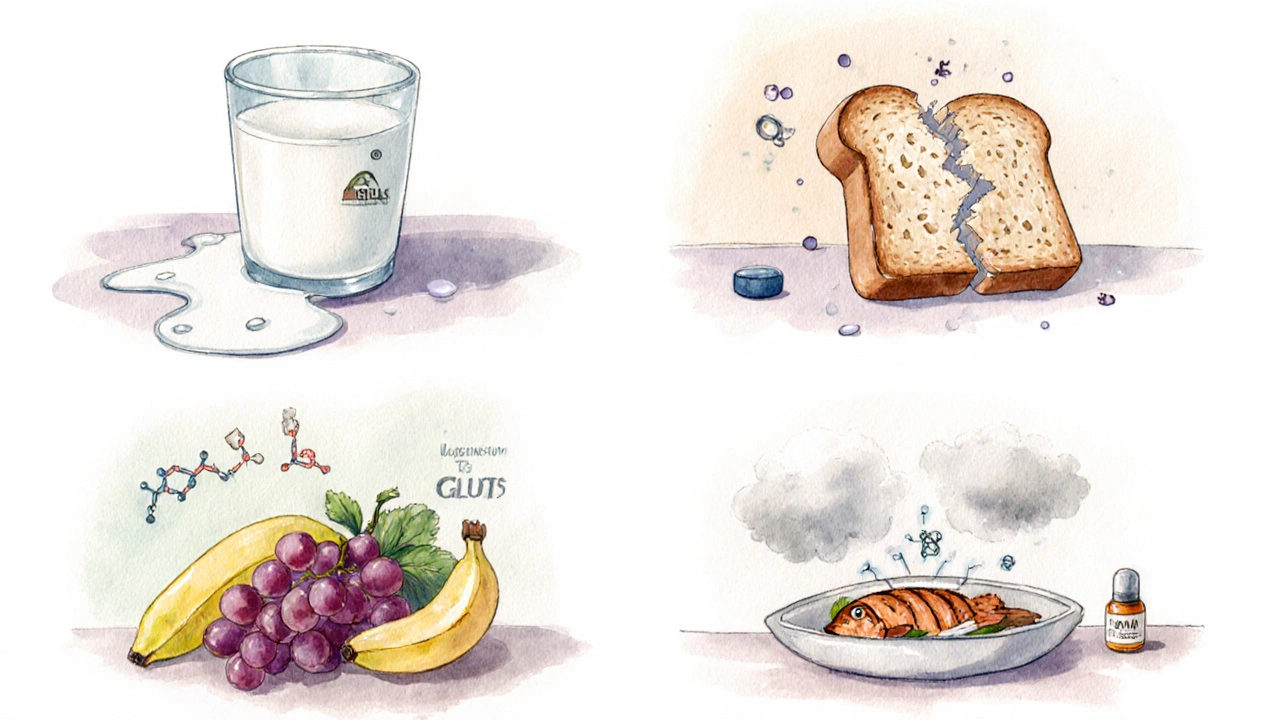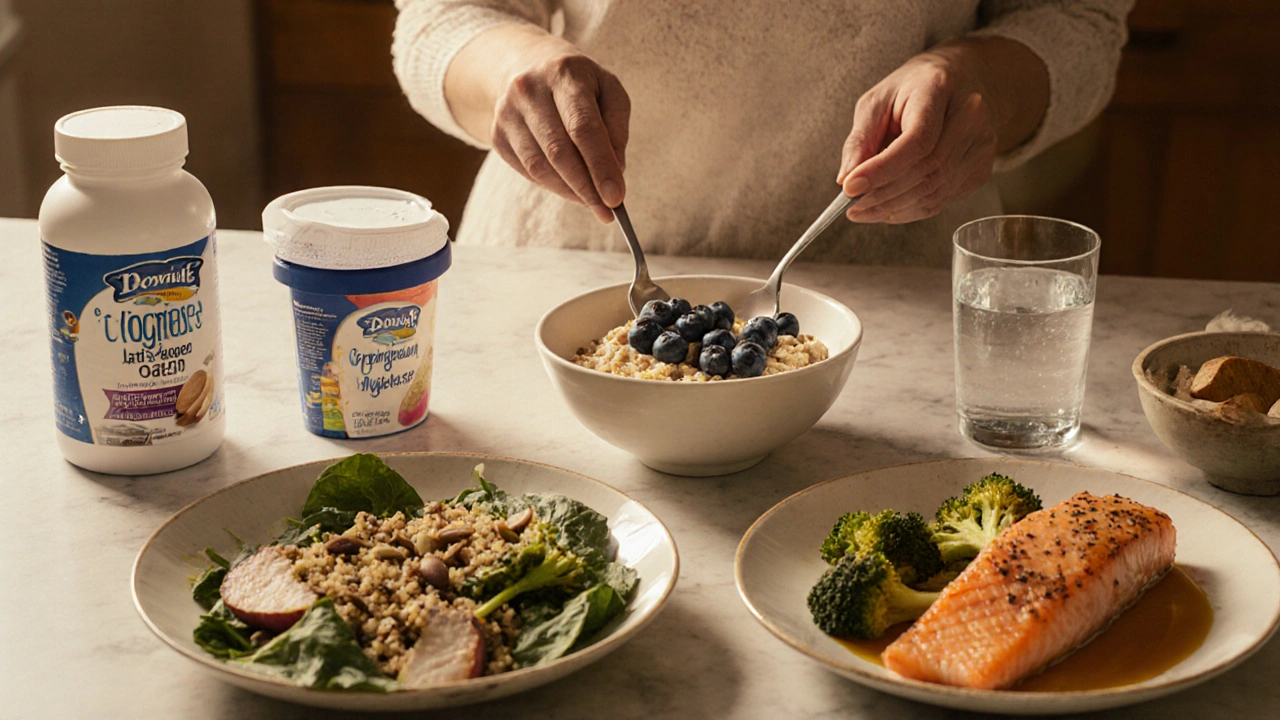Nutrient Malabsorption Risk Calculator
Your Risk Assessment
When your body reacts poorly to certain foods, you might notice more than just stomach upset - you could be missing out on essential vitamins and minerals. This happens because food intolerance can disrupt the way your gut absorbs nutrients, leading to a cascade of health issues.
Key Takeaways
- Food intolerances interfere with digestive enzymes and gut lining, reducing nutrient uptake.
- Common intolerances-lactose, gluten, fructose, and histamine-each target specific nutrients.
- Symptoms of malabsorption often overlap with intolerance signs, making diagnosis tricky.
- Targeted testing and elimination diets can pinpoint the problem and restore absorption.
- Long‑term management includes diet adjustments, supplementation, and gut health support.
What Is a Food Intolerance?
Food intolerance is a non‑immune reaction that occurs when the digestive system struggles to break down a specific food component. Unlike food allergies, which involve the immune system and can cause anaphylaxis, intolerances typically manifest as bloating, gas, diarrhea, or fatigue.
Key mechanisms include enzyme deficiencies (e.g., lactase), impaired transport proteins, or reactions to naturally occurring chemicals such as histamine. When these processes falter, the gut lining may become inflamed, and the surface area for nutrient exchange shrinks.
Understanding Nutrient Malabsorption
Nutrient malabsorption is a condition where the intestines fail to absorb vitamins, minerals, proteins, or fats efficiently. The result is a hidden deficiency that can emerge weeks or months after the offending food is introduced.
Symptoms range from anemia and hair loss to weakened immunity and chronic fatigue. Because the gut is the body’s primary gateway for nutrients, any disruption-whether from structural damage or enzymatic shortfall-can ripple through the entire system.
How Specific Intolerances Undermine Absorption
The relationship between each intolerance and the nutrients it impacts is often direct. Below is a quick snapshot:
| Intolerance | Key Enzyme/Transport Issue | Nutrients at Risk | Typical Signs of Deficiency |
|---|---|---|---|
| Lactose intolerance | Low lactase activity | Calcium, Vitamin D, Riboflavin | Weak bones, muscle cramps, skin issues |
| Gluten intolerance (non‑celiac) | Increased intestinal permeability | Iron, Folate, B‑complex vitamins | Anemia, fatigue, tingling sensations |
| Fructose malabsorption | Defective GLUT5 transporter | Magnesium, Vitamin C, Potassium | Muscle weakness, irregular heartbeat |
| Histamine intolerance | Reduced DAO enzyme | Vitamin B12, Copper, Zinc | Neuropathy, poor wound healing |
| FODMAP sensitivity | Fermentable carbohydrate overload | Various micronutrients due to rapid transit | Generalized fatigue, weight loss |

Lactose Intolerance and Calcium Loss
Lactose intolerance occurs when the small intestine produces insufficient lactase, the enzyme that splits lactose into glucose and galactose. Undigested lactose draws water into the lumen, causing diarrhea and reducing contact time for calcium absorption.
Calcium deficiency can lead to osteopenia, especially in teens and post‑menopausal women. If you avoid dairy without replacing calcium, you risk a silent decline in bone density.
Gluten Intolerance, Celiac‑like Damage, and Iron Deficiency
Gluten intolerance (often termed non‑celiac gluten sensitivity) triggers inflammation without the auto‑immune markers of celiac disease. The resulting irritation opens tight junctions between enterocytes, a condition known as “leaky gut.”
Iron is primarily absorbed in the duodenum, the first part of the small intestine most affected by gluten‑related inflammation. Chronic low‑grade damage can blunt iron uptake, leading to iron‑deficiency anemia that mimics fatigue and reduced exercise capacity.
Fructose Malabsorption and Magnesium Deficit
Fructose malabsorption stems from a faulty GLUT5 transporter that shuttles fructose across the intestinal wall. Excess fructose stays in the lumen, fermenting and creating an acidic environment that interferes with magnesium binding.
Magnesium deficiency shows up as muscle cramps, insomnia, and occasional arrhythmias. Athletes often notice a dip in performance when they consume high‑fructose foods without adequate magnesium intake.
Histamine Intolerance, DAO Deficiency, and B12 Shortage
Histamine intolerance is linked to decreased diamine oxidase (DAO) activity, the enzyme that breaks down dietary histamine. High histamine levels can damage the mucosal lining, impairing the absorption of vitamin B12, copper, and zinc.
Vitamin B12 deficiency is notorious for causing peripheral neuropathy, memory fog, and macrocytic anemia. Because B12 requires intrinsic factor and a healthy ileum to be absorbed, any chronic inflammation from histamine spikes can tip the balance toward deficiency.

Testing and Diagnosing the Link
Because symptoms overlap, a systematic approach is essential:
- Detailed food diary: Log meals, symptoms, and timing for at least two weeks.
- Elimination diet: Remove suspect foods (e.g., dairy, wheat, FODMAPs) for 3-4 weeks, then re‑introduce one at a time.
- Breath tests: Hydrogen or methane breath analysis can confirm lactose or fructose malabsorption.
- Blood panels: Check levels of iron, ferritin, vitamin D, B12, magnesium, and zinc to spot deficiencies.
- Stool analysis: Evaluate gut microbiome composition; dysbiosis often accompanies malabsorption.
For complex cases, a gastroenterologist may order an endoscopy with biopsies to assess villi health, especially when celiac disease is suspected.
Practical Strategies to Restore Absorption
- Enzyme supplements: Lactase tablets before dairy, or alpha‑galactosidase for beans, can reduce fermentative load.
- Targeted nutrient supplementation: Calcium citrate (better absorbed without dairy), iron bisglycinate, magnesium glycinate, and methylcobalamin for B12.
- Probiotic and prebiotic support: Strains likeLactobacillus rhamnosus andBifidobacterium longum help repair tight junctions and improve overall gut health.
- Gradual re‑introduction: Once symptoms stabilize, re‑add foods in small portions to gauge tolerance thresholds.
- Cooking methods: Fermentation (e.g., yogurt, kefir) can pre‑digest lactose, while soaking beans reduces oligosaccharides that cause gas.
When to Seek Professional Help
If you notice any of the following, it’s time to book an appointment:
- Persistent fatigue despite adequate sleep.
- Unexplained weight loss or failure to gain weight.
- Frequent infections or slow wound healing.
- Neurological signs such as tingling, numbness, or memory issues.
- Blood tests that reveal low iron, B12, or vitamin D levels.
A qualified dietitian can tailor a meal plan, while a physician can rule out underlying conditions like celiac disease or inflammatory bowel disease.
Putting It All Together: A Sample Day
Here’s a practical menu for someone with lactose and fructose sensitivities, aiming to boost calcium, magnesium, and iron:
- Breakfast: Overnight oats made with almond milk, chia seeds, and a handful of blueberries; add a calcium‑rich fortified plant‑based yogurt.
- Snack: A small banana with a magnesium‑glycinate capsule.
- Lunch: Quinoa salad with grilled chicken, spinach, roasted pumpkin, and a drizzle of olive oil; sprinkle pumpkin seeds (iron source).
- Afternoon: Lactase‑treated cheese slice on rice crackers.
- Dinner: Baked salmon, steamed broccoli, and sweet potato; finish with a vitaminB12 sublingual tablet.
This plan avoids high‑fructose fruits, limits lactose, and supplies the key nutrients that often slip through when intolerances are present.
Frequently Asked Questions
Can food intolerances cause anemia?
Yes. Intolerances like lactose or gluten sensitivity can damage the gut lining where iron and folate are absorbed. Over time, reduced uptake leads to iron‑deficiency or megaloblastic anemia.
Is a low‑FODMAP diet the same as eliminating intolerances?
Not exactly. Low‑FODMAP targets a group of fermentable carbs that can trigger IBS‑like symptoms, while specific intolerances focus on single compounds such as lactose or gluten. Both can improve absorption, but the low‑FODMAP approach is broader.
Do enzyme supplements fully fix nutrient loss?
Enzyme pills help reduce the immediate digestive distress and can improve short‑term absorption, but they don’t repair damaged intestinal lining. Combining enzymes with probiotic support and targeted supplements yields better long‑term results.
How long does an elimination diet take to show results?
Most people notice a reduction in symptoms within 2-3 weeks. Complete nutrient rebalancing may take 6-8 weeks, especially if deficiencies have built up.
Should I test for celiac disease before cutting gluten?
Yes. If you suspect gluten is the culprit, get serology tests (tTG‑IgA) and possibly an endoscopy before eliminating gluten. Once you stop eating gluten, test results can become false‑negative.





Tracy Harris
October 7, 2025 AT 15:41In the grand tapestry of nutritional science, the author has gravely underestimated the cascading repercussions of chronic intolerance. The narrative, while earnest, omits the stark reality that nutrient deficits precipitate systemic decline far beyond mere fatigue. One must recognize that untreated lactose malabsorption can erode skeletal integrity, ushering in osteoporosis with alarming alacrity. Moreover, the inflammatory cascade invoked by gluten sensitivity does not merely irritate the gut; it silently sabotages iron uptake, precipitating anemia of insidious onset. Consequently, the simplistic diet recommendations offered here border on negligence, demanding a more rigorous, evidence‑based protocol.
Sorcha Knight
October 15, 2025 AT 18:08Whoa, this article really hits the drama ⚡️! I mean, we’re talking about our bodies turning into vamps when we munch on the wrong stuff 😂. If you’re not careful, that latte could be stealing your calcium like a thief in the night! 🌙 Keep those enzymes handy, folks, or you’ll end up feeling like a wilted plant. 🙄
Jackie Felipe
October 23, 2025 AT 20:35i think the post is good but some parts are confusing. like the part about histamine could use a simpler example. also, i saw a typo in "enzyme" written as enyzme. hope that helps.
debashis chakravarty
October 31, 2025 AT 23:01The article contains several factual inaccuracies that warrant correction. Firstly, the claim that "lactose intolerance directly causes calcium deficiency" is overstated; calcium absorption can remain adequate if alternative sources are consumed. Secondly, the usage of the term "non‑celiac gluten sensitivity" should be accompanied by a citation, as the scientific consensus remains ambiguous. Finally, the sentence structure in the section on enzyme supplementation suffers from passive voice; a more active construction would enhance clarity.
Daniel Brake
November 9, 2025 AT 01:28Contemplating the relationship between gut distress and systemic health invites a deeper philosophical reflection. When the body signals deficiency, it mirrors a dialogue between the material and the intangible, urging us to listen to the whispers of our internal ecosystem. Thus, perhaps the true remedy lies not merely in supplements but in cultivating mindful awareness of our dietary choices.
Emily Stangel
November 17, 2025 AT 03:55It is indeed a pleasure to engage with an exposition that attempts to unravel the intricate web of food intolerances and their downstream effects on nutrient absorption. Nevertheless, a thorough analysis reveals multiple layers that merit further elucidation. Firstly, the biochemical pathways through which lactase deficiency hampers calcium uptake involve not only reduced solubility but also altered paracellular transport mechanisms, a nuance that the article glosses over. Secondly, while the discussion of gluten‑related permeability is commendable, it fails to acknowledge the role of zonulin modulation, which serves as a pivotal regulator of tight‑junction integrity. Thirdly, the presentation of fructose malabsorption could be enriched by referencing the SGLT5 transporter, whose dysfunction precipitates the cascading electrolyte imbalances documented herein. Moreover, the author’s recommendation of enzyme supplementation, though practical, does not sufficiently address the necessity of timing relative to meal ingestion, an omission that may diminish therapeutic efficacy. In addition, the section on histamine intolerance would benefit from a deeper exploration of diamine oxidase (DAO) activity variations among different populations, especially considering genetic polymorphisms that influence enzymatic expression. Furthermore, the suggestion to employ a low‑FODMAP diet as a blanket solution overlooks the potential for microbiota‑driven adaptations that can either mitigate or exacerbate malabsorption syndromes over time. It is also imperative to underscore the importance of comprehensive blood panels, not merely as a diagnostic endpoint but as a longitudinal monitoring tool to gauge the success of dietary interventions. Finally, the concluding meal plan, while aesthetically appealing, could be optimized by integrating bioavailable forms of the highlighted nutrients-such as calcium citrate versus calcium carbonate-to enhance absorption in individuals with compromised gastric acidity. In summation, while the foundational premises of the article are sound, a more meticulous articulation of the physiological mechanisms, coupled with evidence‑based recommendations, would elevate the discourse to a level befitting both clinicians and lay readers seeking substantive guidance.
Suzi Dronzek
November 25, 2025 AT 06:21This guide totally misses the mark on real‑world practicality.
Aakash Jadhav
December 3, 2025 AT 08:48Yo, I gotta say, the whole “enzyme thing” sounds like some ancient potion recipe! 😂 But seriously, if you’re tripping over lactose like you’re on a bad rollercoaster, just grab a lactase pill and keep the party going. No need to turn your kitchen into a lab.